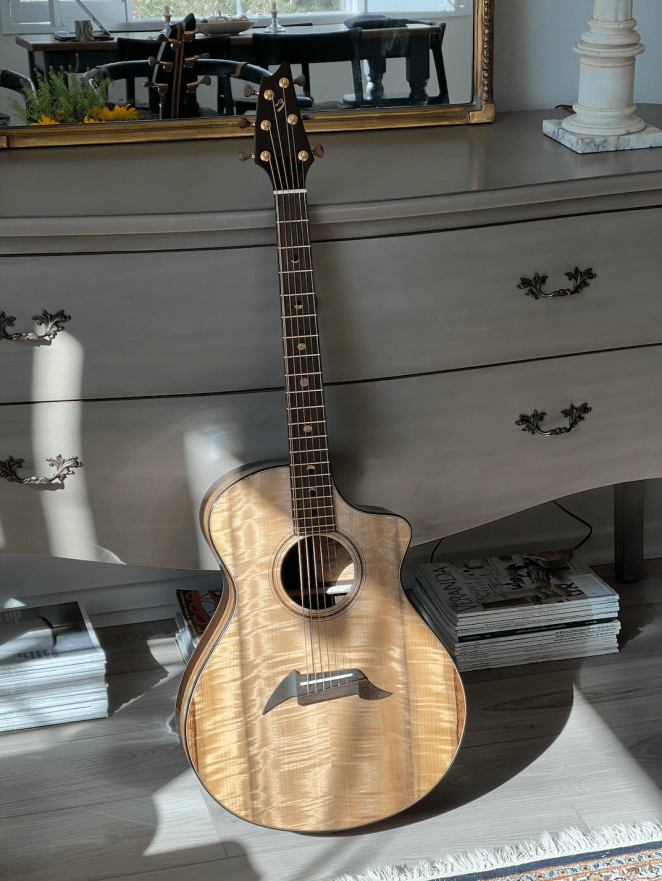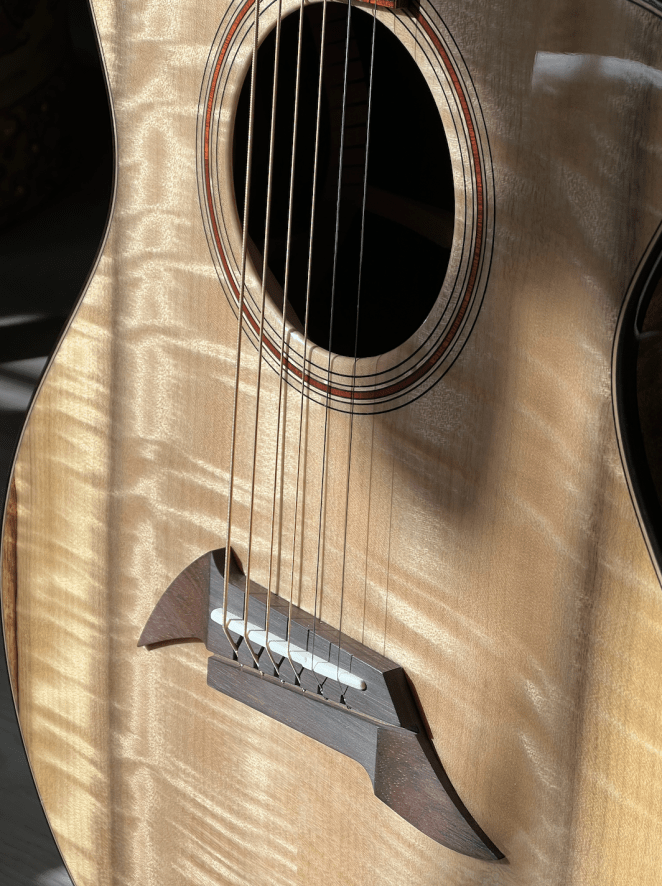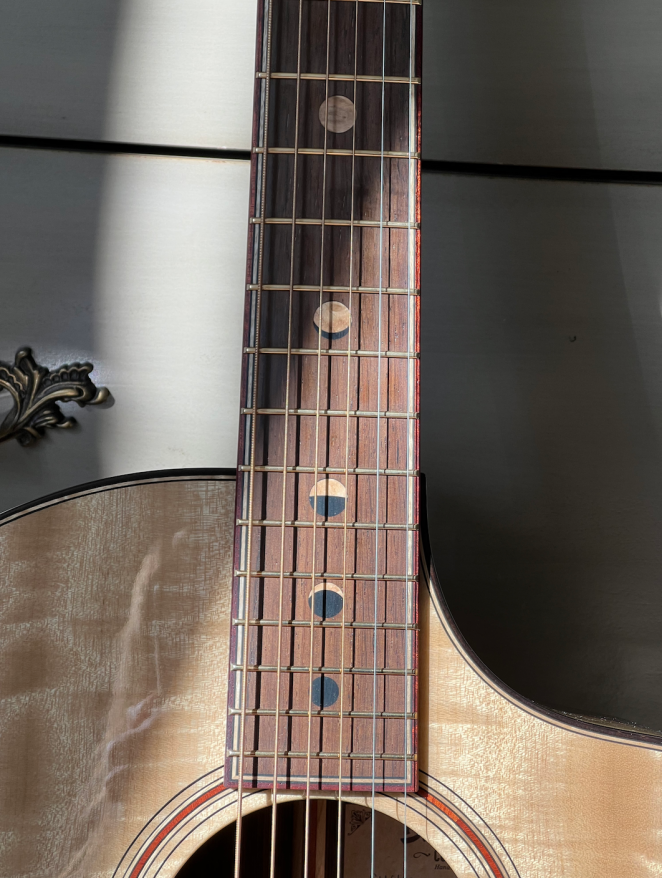The guitar born from Breedlove’s latest collaboration with Sweetwater doesn’t just succeed in its class—it creates a brand new one.
The moment the new guitar’s strings were tuned up, the light background noise of the Breedlove guitar workshop came to a sudden halt. Hands were wiped on rags and feet shuffled nervously as the factory workers gathered around in anticipation to behold the very first notes of this seminal piece of wooden art.
Why so much fanfare from the guitar technicians at Breedlove—a brand that has been putting together about 2,000 guitars every year for the last 35 years?
Because this guitar is different.
Breedlove, in its newest collaboration with Sweetwater, has done something that hasn’t really been done by any other guitar brand in recent history: hand-crafted an acoustic guitar that’s truly the first of its kind.
And the Breedlove guitar technicians weren’t disappointed—from the moment of the first strum, everyone agreed that this guitar sang.
Quick Specs
The Myrzilian 2 is a concert style acoustic guitar, designed by Breedlove’s head designer Angela Christensen in collaboration with Sweetwater’s guitar buyers Thom Grant and Peter Lock—and built with love, of course, by Breedlove’s expert guitar technicians in Bend, Oregon.
The guitar is constructed from a stunning combination of two of the most prized guitar woods in existence: Oregon myrtlewood and Brazilian rosewood. It weighs 4 lbs 9 oz. and retails at $14,999.
The Story
The Myrzilian 2 was, as you can imagine, preceded by the Myrzilian. The Myrzilian marked Breedlove’s first-ever combination of Oregon myrtlewood with Brazilian rosewood—and given how fast the original run of 10 sold out, it was clear they were onto something.
As these things often happen, Breedlove’s Angela Christensen and Sweetwater’s Thom Grant were chilling in Sweetwater’s Crescendo Café for a casual meeting when the ideas that would eventually birth the Myrzilian 2 serendipitously sprang into existence.
As Angela recalls:
We had already introduced the world’s first-ever acoustic guitar that had a Myrtlewood top paired with Brazilian rosewood back and sides, and the reception of that guitar was beyond what we’d imagined. So we were sharing in the success of that project when I proposed the four-piece side concept for the next version of the Myrzilian. What I didn’t expect was the excitement from Thom on the idea, and how he helped further that into what has become the Myrzilian 2.
The rest is history. Angela, Thom, and Peter Lock put their heads together, building upon the already iconic Myrzilian by adding hybrid sides, a gorgeous custom fingerboard inlay, and other appointments that—in my humble opinion—come pretty dang close to perfection.
Build and Design

When you’ve been playing guitar for long enough and you’ve sampled the highest and lowest offerings of most of the main brands, you develop a sort of sixth sense where you can gauge a guitar’s quality just by the feel of it in your hands, before you even play a single note. The second I popped open the clasps on the case and felt this guitar in my hands, it was clear I was dealing with a true work of art.
As it turns out, that “feel” mostly comes down to the build: the materials that make up the guitar, and how they were combined to form the final product.
Below, I’ll tell you everything you need to know about the Myrzilian 2’s construction, broken down into three simple categories: body, neck, and the resulting overall playability.
Body
The Myrzilian 2 has a body composed of both Oregon myrtlewood and Brazilian rosewood. At first blush, this might not sound all that unique, since it’s common for acoustics to be built with a certain type of wood for the top, and a different type of wood for the back and sides.
But to those familiar with the acoustic guitar world, the Myrzilian 2’s body drastically stands out from the crowd for two reasons: 1) Brazilian rosewood is by far the rarest and most coveted species of tonewood in existence, and 2) The body is a perfectly symmetrical combination of myrtlewood and rosewood, with a rosewood back, myrtlewood top, and hybrid sides that combine the two.
Let me quickly elaborate on each of these points, one at a time.
Brazilian Rosewood
For decades, Brazilian rosewood has been the holy grail for high-end acoustic guitars because of its deep, resonant tonal quality and its beautiful grain patterns. The problem is, it was so good that it resulted in severe deforestation, and this in turn led to stringent restrictions on harvesting it.
Brazilian rosewood has been totally illegal to export from Brazil since 1967, and officially listed as a threatened species since 1992, making it illegal to trade without permits. But as it turns out, Breedlove currently has the largest supply of legally sourced Brazilian rosewood in the world, complete with the permits to match.

Not to belabor the point, but just to put into perspective how legendary Brazilian rosewood is: Most dealers will charge upwards of $20,000 for the raw wood alone, and acoustic guitars built with Brazilian rosewood often retail for $50,000 or more. And as a side note, the fact that Brazilian rosewood has been illegal to export since the 60s means the pieces used in the Myrzilian 2 were cut down and exported way back then!
Finally, the Oregon myrtlewood, popularized by Breedlove and harvested right from their headquarters in Bend, Oregon, pairs exceptionally well with Brazilian rosewood—sonically, with its natural “rich bass, warm midrange and clear, bright trebles,” and aesthetically, with grain patterns so striking and vivid they hardly look like they came from planet earth.
Hybrid Sides
Like I said earlier, it’s very conventional for acoustic guitars to be built with a top of one type of wood (usually something like spruce or cedar), and back and sides of another type (usually rosewood, mahogany or maple). With the Myrzilian 2, Breedlove and Sweetwater threw this convention to the wind in the best way possible.
The top of the guitar, along with the front half of the sides, is Oregon myrtlewood, while the back of the guitar, along with the rear half of the sides, is Brazilian rosewood. This results in a striking “yin and yang” appearance, enhanced all the more by a thin stripe of pure red bloodwood running along the entire side perimeter, joining the light beige of the myrtlewood with the dark brown of the rosewood.
And even though the resulting aesthetic is so pleasing, there’s a reason why this specific combination has never been done before: It’s actually really hard to pull off in a lasting way.
Rosewood and myrtlewood have very different densities, which means that as temperature and humidity change, the woods tend to expand and contract at different rates. For most guitar brands, this would likely lead to warping and other structural problems over time. But Breedlove knew exactly what they were doing, treating the woods and building the body with a fine-tuned bracing system that compensates for the differences and ensures perfect stability for as long as the Myrzilian 2 draws breath.
These hybrid sides, as well as the combination of myrtlewood and rosewood in general, are perhaps the clearest examples of Breedlove really carving out its own unique space in the acoustic guitar world—“coloring outside lines,” as Thom Grant puts it.

I’m certainly here for it.
Neck
The Myrzilian 2 has a neck of East Indian Rosewood, a dense hardwood with a deep brown color, perfectly suited to handle tension from the strings without warping. The back of the neck features a striking triple stringer, perfectly themed with the body: red bloodwood running up the center, bordered on either side by beige myrtlewood. And the three-piece stringer continues inside the body, running all the way down the backstrap and onto the tailblock.
The Myrzilian 2’s fingerboard features a stunning “moon phase” inlay, a series of spherical designs resembling the different phases of the moon: crescent on the third fret, full on the ninth fret, and back to crescent on the 17th fret.
This work of art was the pet project of Sweetwater guitar buyer Peter Lock, along with Breedlove’s Angela Christensen. As Peter recounts:
We really went into the weeds on this and sent numerous iterations back and forth to make sure the orientation, materials and sizing looked correct. Because the space between frets gets smaller the further up the board you go, we worked a lot on making sure everything looked appropriate as you follow the pattern. Throughout the whole process, Angela was incredibly collaborative and great to work with.

And in case you’re wondering, yes—it’s absolutely unusual for a guitar brand to go in on a completely custom fingerboard inlay like this. Most brands typically offer just a few standard designs to keep production simple. The fact that Breedlove has the time and bandwidth to collaborate with designers on details like fingerboard inlays really does demonstrate a commitment to craftsmanship and creativity that, unfortunately, is all too rare nowadays.
Finally, no one is going quite so far as to claim that the Myrzilian 2 was “meant to be,” but it just so happened that the moon phase fingerboard was designed right around the total solar eclipse of April 8th, 2024—an event that won’t happen again until 2044!
Playability
Now for the fun part. I spent many intimate hours with the Myrzilian 2, and had my brother—an accomplished bluegrass flatpicker—get to know it as well. We both agreed that this guitar is one of the silkiest, easy-to-play acoustics we’ve ever felt. Here’s why:
- Perfect balance: Rest the indent on your right leg and remove your arms from the guitar, and the neck just barely falls down into your outstretched left hand. Put your right arm over the body to access the strings, and you’re working with a guitar that requires absolutely zero effort to keep it in playing position.
- Flawless action: An action that’s too high makes for a clumsy, strenuous playing experience, and an action that’s too low results in some unpleasant buzzing. The Myrzilian 2 strikes the perfect balance, with a wonderfully close action that makes fretwork effortless, but also stays just high enough to avoid the dreaded buzz.
- Smooth neck: The back of the neck has a beautiful matte finish, which means your fretting hand can slide up and down the neck with minimal friction—even if it’s a sweaty, two-hours-into-a-recording-session hand.
- Excellent intonation: Imperfect intonation has haunted me on most guitars I’ve owned, and so it was remarkable to play the Myrzilian 2, where this problem literally doesn’t exist. I would tune the guitar up once, and that would be the end of the story—whether I was playing out of C, G, or even hitting some whacky bar chords, it just stayed in tune.
Overall, the Myrzilian 2 achieves the full hat trick when it comes to build and design: construction with the finest materials worldwide, innovative and striking aesthetics, and silky-smooth playability that encourages multi-hour playing sessions.

Sound Quality
We’ll wrap up this review with a quick look into what’s undoubtedly the most important aspect of any musical instrument: the nature and quality of the sounds it produces. The key word to use when describing the Myrzilian 2’s sound quality is “balance.”
My main guitar is a full-mahogany Martin D-15, and when I picked up the Breedlove and heard it for the first time in reference to the Martin, I was immediately struck by how even and clear the tones were across the entire range. Some of this, of course, is to be expected when switching from a boomy, full-size dreadnought (like my Martin) to a smaller concert style (like the Myrzilian 2)—but in this case, it’s much more than that.
The Myrzilian 2 truly delivers a beautifully nuanced sound, with crisp, clear highs that don’t overshadow the warm midrange and solid lows that never get muddy.
I really think this tremendous tonal balance is due in large part to the guitar’s unique construction—which I’ve already talked so much about. Sweetwater’s Thom Grant put it really nicely:
It’s nice to know that there are still builders and companies that exist who are willing to try new things and give artists a type of voice that quite literally hasn’t existed yet.
Playing the Myrzilian 2, you really will get this feeling that you’re working with a fresh palette of sounds that have never been woven together in quite this way before.
And believe me, I tried everything: fingerpicking, strumming with my finger, strumming with a pick, and even handing it off to my brother for some intense bluegrass soloing. Whatever style you’re into, the guitar really just sings and brings out the best in each technique.
Final Thoughts

There’s something special about acoustic instruments. I don’t know if it’s that they’re made from trees that were once living just as we are, the way they resonate with sonic energy at our command, or because they can so beautifully enhance the stories we humans like to tell with our words.
What I do know is that the Myrzilian 2 is one of the finest guitars I’ve ever played, a guitar that’s fully worthy of every one of those highfalutin thoughts above.
When you buy a Myrzilian 2, you’ll be holding in your hands a collection of materials that have existed since before Columbus came to America—pieces of trees that grew up thousands of miles apart on two different continents, across both the Old World and the New.
It’s a truly timeless instrument—one that will invite you to join it in creating your own stories together.
Fuente





